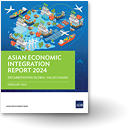The Implications for Asia of US Monetary Policy
Interest rate hikes in the United States would exert significant impacts on Asian economies through trade, exchange rates, and financial markets.
The fight against the pandemic has left a large imprint on the US Federal Reserve’s balance sheet. Since the outbreak of the pandemic in early 2020, the US Fed has purchased a wide range of assets and pumped liquidity into the financial system to cushion the impact of the pandemic and fiscal stimulus on interest rates.
Its balance sheet ballooned to nearly $9 trillion, compared with the pre-pandemic level of $4 trillion. To put this number in perspective, the added $5 trillion in the US Fed’s assets is roughly the same size of total overseas claims by Asian banking systems.
With the extraordinary fiscal and monetary policy support, the US economy has staged a strong recovery since 2020 Q3. The economy grew 5.7% in 2021, which is the highest annual growth since 1984. Domestic demand has been rising even faster.
By any measure, the US economy now runs on its full capacity. Unemployment rate fell to 4% and inflation climbed to 7.5%. This prompts the Fed to begin contemplating the path to normalize its monetary policy. On January 26 this year, the Federal Open Market Committee, which is an ultimate monetary policy decision making body, confirmed that the Fed is ready to raise interest rates and gradually reduce the size of the Fed’s balance sheet.
Unfortunately, without exception in the past four decades, the Fed’s tightening cycle led to economic slowdown in the United States and/or preceded financial crisis in emerging market economies. Between 1980 and 1982, monetary tightening led to a recession. Interest rate hikes between 1986 and 1989 triggered the savings and loan crisis and later combined with the oil price shock of 1990 to lead to a brief recession in the US.
The Fed embarked on tightening in 1993, leading to significant rises in long-term rates and companies’ borrowing costs. While the US avoided a recession during this tightening cycle in 1993-1994, a sudden reversal in capital flows and the collapse of the Mexican peso in December 1994 led to a series of financial crises in several Latin American countries during 1994-1995, and in Asian economies during 1997-1998.
Monetary tightening between 2004 and 2007 pricked the bubble in the US housing market and pushed the global economy into a financial crisis and an economic recession in 2008-2009. The last tightening cycle of the US Fed during 2015-2018 was cut short as quantitative tightening led to negative market reactions. Soon afterwards the world was hit by the COVID-19 pandemic.
Interest rate hikes in the United States would exert significant impacts on Asian economies through trade, exchange rate, and financial market channels.
First, higher interest rates curb aggregate demand, hence reducing external demand for Asian exports. Second, higher yields on US assets attract international investment and create strong demand for dollars. The impact of the dollar appreciation on Asia’s trade remains ambiguous. Third, the transmission of higher US interest rates through international capital markets would exert downward pressure on local investment and consumption. Empirical evidence shows that local interest rates in Asian developing economies respond to short-term US rates in a strongly positive manner regardless of existing exchange rate regimes.
Empirical evidence shows that local interest rates in Asian developing economies respond to short-term US rates in a strongly positive manner regardless of existing exchange rate regimes.
Emerging market economies are expected to navigate increasingly turbulent waters ahead. An immediate challenge for the region is to strengthen macroprudential surveillance and preempt new sources of financial instability.
First, while still manageable, inflation has picked up in many regional economies, driven by strong economic recovery, high food and energy prices, and increased shipping costs. Monetary authorities in the region need to carefully monitor the risks of higher inflation and prepare to rein in inflation expectations. Once the Fed starts raising interest rates, local currency depreciation driven by widening interest differentials could further complicate the inflation battle.
Second, an extended period of very low interest rates has created a legacy of record-high debt in both corporate and household sectors. As the authorities lift regulatory relief and forbearance measures while monetary policy support wanes, there will be lagged effects of COVID-19 on corporate defaults and loan losses.
Nonperforming loan ratios already rose in a number of regional economies albeit from a low base. Financial authorities should closely monitor the risks and take early actions to prevent the buildup of systemic risks. For example, preventive debt restructuring can offer companies a second chance at rehabilitating debts and provides banks more certainty in assessing the debt risks.
Third, expansionary fiscal policy in response to COVID-19 boosted government debt issuance in many regional economies. The prospect of US interest rate hikes could increase the cost of borrowing even before the US interest rate hikes. The risk of debt vulnerability runs high, especially for the economies facing high external debt service burden while sustaining large structural current account deficits and holding insufficient foreign exchange reserves.
In order to mitigate external vulnerabilities, more proactive public debt management is needed, for example by lengthening the maturity structure and building a more sustainable debt service profile. The region also needs to further local currency bond and capital market development to reduce reliance on external debt financing and improve financial resilience.
Fourth, massive and at times highly volatile global capital flows can disrupt the region’s macroeconomic and financial stability. With the imminent changes in the US monetary policy stance, capital flows to the region could reverse with the risk of sudden stops.
Although the region’s strong growth outlook and healthy external positions mitigate the risk, authorities need to remain vigilant and prepare for a sudden change in international investor sentiment. Effective capital flow management, including foreign exchange and capital control measures, is key to that preparation.
Fifth, emerging market and developing economies in the region would benefit from strengthening the global and regional safety net arrangements to support crisis prevention and management. Past financial crises illustrate that macroeconomic stabilization policies alone are not sufficient for safeguarding financial stability.
Globalized finance requires a solid global defense against financial crisis. Effective financial safety nets should have multiple layers in both crisis prevention and crisis management. This must begin with sound macroeconomic policies at the national level, more flexible and targeted assistance at the regional level, and eventually backstopped by global cooperation.
Finally, strong economic recovery is the only way out of the crisis. Asia needs to seize the opportunities arising from rapid digital transformation to further boost productivity and capture potential gains in economic growth and employment.
The region’s policy makers must promote broader and more equal access to digital opportunities by enhancing digital infrastructure and expanding human capacities, especially for the poor and disadvantaged, through investments and policy reforms in education, health, and public services.
Original article was published at the Asian Development Blog and duplicated here with permission from the author. *




